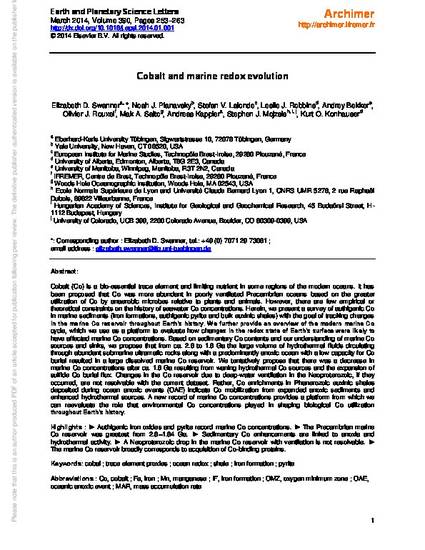
Article
Cobalt and marine redox evolution
Earth and Planetary Science Letters
(2014)
Abstract
Cobalt (Co) is a bio-essential trace element and limiting nutrient in some regions of the modern oceans. It has been proposed that Co was more abundant in poorly ventilated Precambrian oceans based on the greater utilization of Co by anaerobic microbes relative to plants and animals. However, there are few empirical or theoretical constraints on the history of seawater Co concentrations. Herein, we present a survey of authigenic Co in marine sediments (iron formations, authigenic pyrite and bulk euxinic shales) with the goal of tracking changes in the marine Co reservoir throughout Earth's history. We further provide an overview of the modern marine Co cycle, which we use as a platform to evaluate how changes in the redox state of Earth's surface were likely to have affected marine Co concentrations. Based on sedimentary Co contents and our understanding of marine Co sources and sinks, we propose that from ca. 2.8 to 1.8 Ga the large volume of hydrothermal fluids circulating through abundant submarine ultramafic rocks along with a predominantly anoxic ocean with a low capacity for Co burial resulted in a large dissolved marine Co reservoir. We tentatively propose that there was a decrease in marine Co concentrations after ca. 1.8 Ga resulting from waning hydrothermal Co sources and the expansion of sulfide Co burial flux. Changes in the Co reservoir due to deep-water ventilation in the Neoproterozoic, if they occurred, are not resolvable with the current dataset. Rather, Co enrichments in Phanerozoic euxinic shales deposited during ocean anoxic events (OAE) indicate Co mobilization from expanded anoxic sediments and enhanced hydrothermal sources. A new record of marine Co concentrations provides a platform from which we can reevaluate the role that environmental Co concentrations played in shaping biological Co utilization throughout Earth's history.
Keywords
- cobalt,
- trace element proxies,
- ocean redox,
- shale,
- iron formation,
- pyrite
Disciplines
Publication Date
March 15, 2014
DOI
10.1016/j.epsl.2014.01.001
Publisher Statement
This is a manuscript of an article published as Swanner, Elizabeth D., Noah J. Planavsky, Stefan V. Lalonde, Leslie J. Robbins, Andrey Bekker, Olivier J. Rouxel, Mak A. Saito, Andreas Kappler, Stephen J. Mojzsis, and Kurt O. Konhauser. "Cobalt and marine redox evolution." Earth and Planetary Science Letters 390 (2014): 253-263. Copyright 2014 Elsevier B.V. Posted with permission.
Citation Information
Elizabeth D. Swanner, Noah J. Planavsky, Stefan V. Lalonde, Leslie J. Robbins, et al.. "Cobalt and marine redox evolution" Earth and Planetary Science Letters Vol. 390 (2014) p. 253 - 263 Available at: http://works.bepress.com/elizabeth_swanner/7/
Creative Commons license

This work is licensed under a Creative Commons CC_BY-NC-ND International License.
